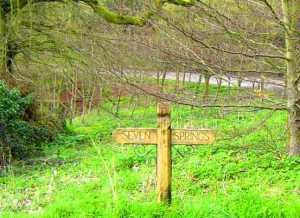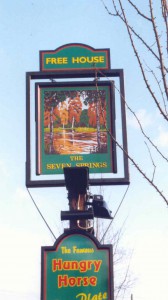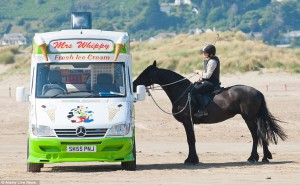Falling Down the Thames Blog 7, 30th April 2014
Everything I Know About Seven Springs
Having described the village of Kemble, which may be the closest community to the head of the River Thames, it must surely be time to describe the other contender.
As explained in an earlier entry, the Thames may begin near the settlement of Seven Springs. The springs in question serve as the headwaters of the Churn River which flows through Cirencester and, according to some, drain into the Thames at Cricklade. Others feel that the Churn River becomes the River Thames at Cricklade, and whatever little dribble of water is found near Kemble is just an insignificant offshoot.
Seven Springs is a hamlet in Gloucestershire, six kilometres from Cheltenham. An assortment of dictionaries on my desk told me that a hamlet is a collection of homes in the countryside, too few to be a village. A hamlet is even too small to have a church. If you feel the need to drive to Seven Springs, you will find it at the intersection of the A435 and the A436. The head of the Churn, or perhaps the Thames, is about 75 metres from the intersection.
If you are without means of private conveyance, it is possible to get to Seven Springs from larger centres by public transportation. At three minutes to the hour, the First Great Western rail service towards Bristol departs from Paddington Rail Station in London. Arriving at Swindon, a twelve minute walk is required to get to Bay 16 at the Swindon Bus Station. This is followed by a 79 minute bus ride on Stagecoach line 51 toward Cheltenham.
But what about Seven Springs itself? Consulting the Domesday Book about Seven Springs didn’t tell me much. Seven Springs is close to settlements that are listed in the Domesday Book. These include Broadwell, Dowdeswell and Owdeswell. Wells and springs go together, I suppose. Within five kilometres of Seven Springs are Hilcot, Upcote and Foxcote, as are both Little Colesbourne and Great Colesbourne. But not Seven Springs per se.
I gather that Seven Springs is home to Seven Springs Inn, Seven Springs Cottages, and Sandford School, and not very much else. None of these building sites appear to date back to the eleventh century, which may help explain the silence of the Domesday Book.
A hamlet may be too small for a church, but that doesn’t preclude a pub; Seven Springs has one of those. The Hungry Horse is one of a nation-wide chain of pub/eateries. The menu includes prawn cocktail, tomato and basil soup, BBQ pulled pork and chicken New Yorker. One can also choose from among eight cocktails, and there is an extensive children’s menu. I have never drank in a pub that served prawn cocktails. Or children for that matter.
Kemble or Seven Springs? Seven Springs or Kemble? What possible difference could it make to Krista and me exactly where we start paddling? For one thing, if we consider the head of the Thames River to be at Seven Springs rather than at Kemble, our paddling journey will be twenty-three kilometres longer. By itself that isn’t much of an issue. However, the additional paddling would make the Thames River fourteen kilomeres longer than the Severn River otherwise the longest river in England and Wales, and eight kilometres longer than the River Shannon, the longest river in the British Isles.
Decisions, decisions.
- Glen
Photo credits: Seven Springs – thames.me.uk; The Hungry Horse – static.panoramio.com; a hungry horse – i.dailymail.co.uk



